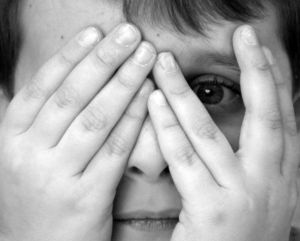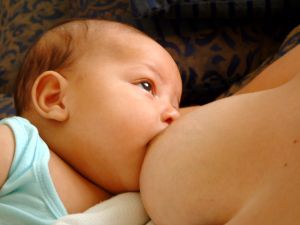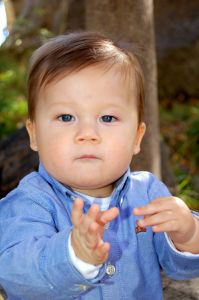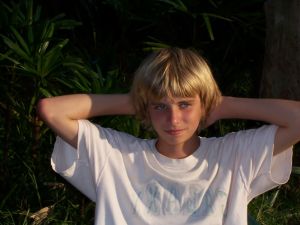By Rita Brhel, managing editor and attachment parenting resource leader (API)
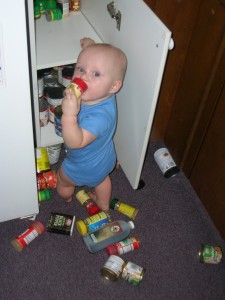
My youngest daughter is turning one year old this month. It’s amazing how much she’s changed since she was born – she’s learning to walk, waves bye-bye and says “yeah,” and is getting her fingers into everything! She’s also learned how fun it is to pull her sister’s hair.
Each time my two-year-old cries from the hair-pulling, I come over, gently pry the baby’s hands out of her sister’s locks, and say, “No, no…We don’t pull hair. Pulling hair hurts.” Does it work? No. But that’s OK because she’s only a baby. She isn’t old enough yet to know what “no” means, to know the difference between yes and no, to know what it means that something hurts.
The best way to get the baby to stop doing something I’d rather her not do is to remove it from the picture – if I don’t want her to take all the DVDs out of the cabinet, I put a lock on the doors, and if I don’t want her to mess with the on/off button on the TV, I tape a piece of cardboard over that button and rely on the remote.
The difference here is that I can’t remove her sister from the picture. I also need to remember that I’m teaching fairness. I want my two-year-old to see that I’m treating her and her sister fairly when it comes to hair-pulling, even if her baby sister is just a little too young to know what “no” means. I don’t want jealousy brewing, and I don’t want my toddler to resent her little sister. What is she learning if I say “no” to her when she pulls someone’s hair but not do the same when the baby is the one pulling her hair?
Changing the Spanking Mindset
When my toddler was this age, I was struggling with whether to begin discipline or what kind of discipline I should do. I grew up in a household with spanking. I didn’t know that spanking wasn’t really a form of discipline until I found Attachment Parenting International.
Before, I thought discipline and punishment with synonymous, and I thought spanking was a normal reaction of angry and frustrated parents. That was something I didn’t want to do, but yet, I didn’t want my children to be spoiled and selfish, either. I didn’t know what to do. I didn’t want to spank, but I didn’t know any other way.
It took a lot of willpower and a lot of studying and reading, before I found my “brand” of discipline, what I call the individual way each parent disciplines (within the parameters of positive discipline, that is). I learned that discipline and punishment were two very separate things: that discipline was meant to be loving while teaching the child, even when children push the limits and do hurtful things, and that punishment didn’t really teach the child to do anything but fear his parents and fear “getting caught.” I didn’t want my children fearing me; I wanted their respect. There is a difference.
Eliminating Anger
Lastly, I had to go through the very difficult process of removing anger from my life, not only when I needed to discipline but when I was irritated at my husband or frustrated with life in general. Interestingly, it was while trying to apply the techniques from Adele Faber and Elaine Mazlish’s book How to Talk So Kids Will Listen and Listen So Kids Will Talk that I learned how to take anger out of disagreements with my husband. The skills I was building had spilled over to the rest of my life.
Once I took the anger out of the equation, it was easy not to spank. There was no need! I learned to get my child’s attention in a different, non-violent way. I prefer to have her look at my eyes while I explain why we don’t do what she did, and if I sense a tantrum coming on, I take her to her room to do the same and for her to have a quiet place to release that emotion. Often, when upset or frustrated, she chooses on her own to run to her room and then, in a minute or so, comes out when she’s calmed down. Sometimes, I follow her; sometimes, she seems to prefer to control how she calms down, and that may mean without me.
The Power of Reconnecting
I can’t say I didn’t slip up and revert back to that default playing in my head to spank my child. I did…many times unfortunately during the first few months of trying to change. But I learned a wonderful tool from Pam Leo’s book Connection Parenting that I simply refer to as “reconnecting.” I apologize to my daughter, hug her, and let her know that I know I slipped up and that I am working on it.
Reconnecting allowed me a way out, so that I didn’t become consumed by guilt and frustration. Then I regrouped myself and started over.
Another interesting note: My husband and I have started to do the reconnecting in our relationship by holding hands and looking at each other to block out distractions, including our children at those times, to take the time to apologize and say “I love you.” This technique has greatly improved our connecting during tense moments.
Understanding the Real Reason for Acting Out
I have also found that many of the most challenging times occur when either my toddler or I need a nap. Dirty diapers, late lunches, illness, boredom, and not enough one-on-one time certainly can play a part, too. This was an eye-opener for me: My toddler wasn’t acting out because she was intentionally trying to push my buttons, but because she was physically or emotionally uncomfortable. She tends not to tell me that her diaper needs changing until it’s very full, and at the end of the day, she gets anxious for her daddy to come home from work, and sometimes, she just wants to go run in the backyard instead of playing in the living room.
Baby See, Baby Do
Learning how to change my discipline-oriented programming wasn’t easy, but it was well worth it. Discipline is no longer stressful, and deciding when to begin disciplining my second child really isn’t even a question.
Since discipline isn’t punishment and is actually teaching, we’ve all been disciplining since birth – by teaching what to do or not do by how we live our life right from the beginning. Teaching by example is the most powerful discipline tool I’ve come across, even more so than positive reinforcement.
My toddler hugs and kisses the baby like Mommy does, and she plays with the baby like Mommy does. Both of my children are learning what is normal from what I do, and if I handle my frustration in a way that promotes attachment, they surely will learn that, too.
Since discipline isn’t punishment and is actually teaching, we’ve all been disciplining since birth – by teaching what to do or not do by how we live our life.


